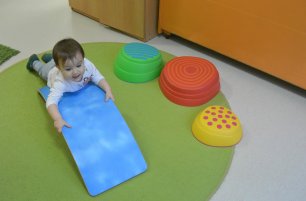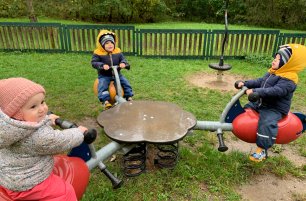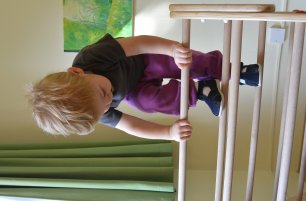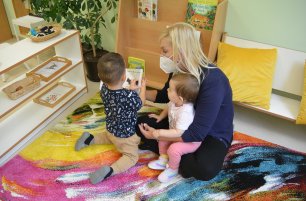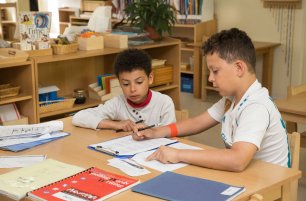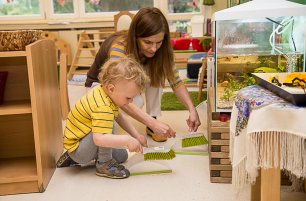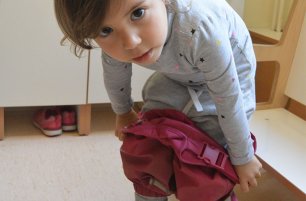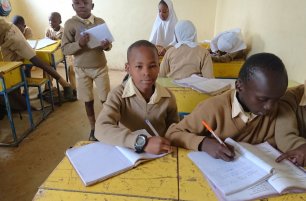Helping your Toddler on their Path of Development
Parents today are constantly surrounded by images and ideas of what their children should or shouldn’t have and it can be overwhelming trying to decide what is best for their child’s development. Every parent wants to make good decisions when it comes to the items you choose to bring into your home, but how do we know which ones are more or less beneficial than others?
Movement and Language are the longest periods of learning
As parents and educators, it all comes down to knowing the areas to focus on in your child’s development and how to best support their needs as they grow and learn. These fundamental areas of development are language and movement. Maria Montessori believed that the window of opportunity for language begins around 7 months during pregnancy and lasts until the child is approximately 5 years old - making it the longest critical period of learning. Movement begins while the child is still inside their mothers’ womb and it continues to develop from the moment of birth and for years to come. When we use items that obstruct the child’s need for free movement and communication, then the development in these areas becomes stunted.

Pacifiers - Effects on speech and oral development
Originally pacifiers were intended as a way for infants to practice the movement of sucking, strengthen the mouth muscles, and calm themselves through this action. But today they are being overused, especially considering the age at which children are still using pacifiers well after their infancy, and parents are using them just to get their child to stop crying, be quiet, or go to sleep. Parents use these for many different reasons but the bottom line is that they are not beneficial for your child’s development.
Pacifiers are a great help when you need sleep or some peace and quiet, but your infant needs to practice using their vocal chords every day in order to develop their speech. It may sound like nonsense to us, but to them it’s very important work. Through practicing sounds, they are strengthening their vocal chords, developing mouth muscles and movements, and starting to understand volume and tone.
When your child’s teeth are coming in and they are sitting at mealtimes rather than being held, these are signs that the need for sucking is less. Pacifiers can create problems with teeth coming in the wrong position, preventing proper mouth development, and they completely limit your child’s ability to communicate. This can create further issues with speech, pronunciation and language development. These negative effects can take years to recorrect, not to mention the toll it will take on your bank account if your child needs dental or orthodontic work done.
What is happening emotionally?
Also we must consider the emotional effects this item has on your child. When your toddler is crying, babbling, or simply will not stop talking, what message do you think it sends when we put something in their mouth which obstructs their ability to communicate with us? We should be using any and every opportunity to develop our children’s conversation and vocabulary skills. Children can also become emotionally dependent on pacifiers because they are given during times of distress, which leads your child to believe this item is what brings them peace and comfort. Ultimately, this can make your child more likely to be emotionally dependent on other things later in their life.
Baby Walkers and Bouncy Chairs
These items are tempting because they are full of colors, sounds, and seemingly appropriate activities to keep your toddler’s attention. However, besides the fact that they can be overstimulating, any time that a child is placed in something where they do not have free access to move in or out by themselves, it is obstructing their development and the need for free movement. Your young child is learning how to move their body within their environment so when placed in a baby walker, he or she is getting the wrong information about their body and how it moves in space. Your child will try to walk and move around but with a large, heavy object stationed around their waist then they are unable to learn where their body ends and the environment begins. There is a clear need for toddlers to move their bodies freely so it’s important that we provide this outlet in the right way.
Crib Beds and Play Pens
Cribs are the most commonly used beds for infants and toddlers because adults feel they are the most effective option to keep their child safe while sleeping. Play pens are also advertised as a way to keep the child safe and in a contained area while parents are doing other things. However, we must consider how these structures affect the child’s physical and emotional development. Anything with bars or high sides will obscure your child’s vision and ability to see their environment, also limiting their opportunity for free movement. From birth, infants begin to develop their ability to visually focus on various objects and people which helps establish order and creates points of reference for them - all through visual observation. It’s important that infants have a clear, unobstructed field of vision and a rich variety of colorful, attractive and interesting things to look at.
There is also a loss of independence when a child is placed in a structure where they cannot move in and out by themselves. This creates a feeling that he or she needs the adult and they cannot help themselves independently. These structures take away confidence and self esteem, unlike a low lying floor bed which allows the child to crawl in and out by themselves and gives them unobstructed vision. This builds their sense of self worth and an “I can do it myself” attitude.
Ourselves - How we play the biggest role
The biggest obstacle to our children’s development is sometimes caused by our own actions and attitudes, even when we are trying to help. We must prepare ourselves mentally and emotionally to allow freedom and independence for the child to make mistakes, and react in a gentle and encouraging manner. Try not to rush in to help or do things for your child, instead give them time to process what you are asking them to do and allow the space to make mistakes and learn from them. You can offer support but remember this is their opportunity to learn and practice their skills so it’s important to allow for the time and space they need.
Exploration builds concentration
As parents and educators, we often feel a need to constantly engage or entertain our children. However, in the classroom we strongly value undisrupted concentration and self exploration. Janet Lansbury writes that “[children] don’t get bored unless parents have conditioned them to require external stimulation and entertainment.” This means when we are constantly offering our children the next best thing to keep them entertained, it is actually decreasing their ability to concentrate for long periods of time. This will eventually condition your child to lose interest in activities more quickly. So let your child wander around the house or garden and give them an opportunity to find an activity that interests them without your help. “[When] we trust a child to strengthen his learning abilities through natural, self-directed exploration, we will observe [them] engrossed in activity for longer periods of time than we might think possible” (Janet Lansbury).
